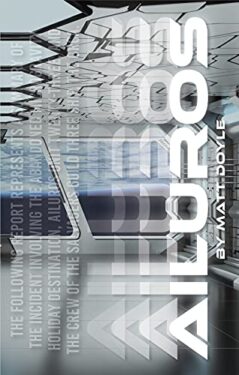 Ailuros
Ailuros LGBTQ Science Fiction, First Contact, Sci Fi Horror
Fractured Mirror Publishing
Sept 7, 2021
Kindle
195
Amazon
#Begin *Ailuros*
In the *present // future*, Alex and Josh must face *their own // a* monster if they are to salvage *their relationship // Ailuros Unit 23* ;
These *are not* separate stories.
The following report represents a summary of the incident involving the abandoned microgravity holiday destination, Ailuros Unit Twenty-Three, and the crew of the Salvagers Guild Three ship, The Orca. The report is comprised primarily of the official transcripts of both the aforementioned events on board the unit and my interview with Guild Director, Sarah Walker. The final entry consists of my summarizing thoughts on the case.
As is often the case in investigations such as this, in the end, Ailuros itself is as much the key to understanding the events as the people involved are.
Circumstances as well as personal choices are important, after all.

Review by Gordon Phillips
Member of the Paranormal Romance Guild Review Team
Matt Doyle describes “Ailuros” as “the most complex book I have written,” and certainly it is a complex piece of writing. Its structure is similar to Nabokov’sPale Fire—which has been described by reviewers as a work of art, this being the closest they could come to describing what is a poem with attendant commentary. Nabokov himself connects the two components, explaining their use within the poem:
Man’s life as commentary to abstruse Unfinished poem – note for further use.
The word art itself, originally meaning skill or craft, is apt for both Pale Fire and “Ailuros,” as such complex structures require more than mere creative imagination; namely considerable skill and craft in forming the whole. That both are not always present can be read in the biographies of artists bemoaning the realization that their technical skills were not sufficient to manifest certain of their creative ideas. It is one thing to imagine forms that lie outside convention, quite another to create them so that they work. That Nabokov managed this is, perhaps, only to be expected; that Doyle did so as well in “Ailuros,”makes for a delightful and happy discovery.
The basic structure of “Ailuros” is that of an adventure/horror sci-fi story plus commentary. The hardcopy was to be formatted so that the two components run in parallel, the story on the right-hand pages, the commentary on the left-hand pages. The story is what Doyle calls “an LGBTQIA+ homage to Alien.” It follows the experiences of group of salvagers who encounter a derelict ship floating in space.
The commentary begins with the narrator Alex’s a half-hearted apology for, and explanation of, the adjacent story. He tells how he put his own Neg-Vac drug into his husband Josh’s tea, and then put him inside an Alleviation Sim (simulator) unit. The result was a kind of a pseudo-therapeutic fantasy, based on elements of Josh’s own subconscious and created by an AI(artificial intelligence) interpreter. The report (“transcription”) of this session is the story on which Alex is commenting.
Alex gives his motivation as the oldest one in the book: his anxiety about the state of their marriage after having seen Josh engaging in sex with an ex-lover. As Alex puts it, he was desperate, and needed to know what Josh’s real feelings were and whether there was hope for them.
Having received the manuscript of “Ailuros” with the commentary as endnotes, I read the story first. On its own, it is a gripping tale. There are the elements of good horror in the bloody encounters with the thing that has invaded the derelict ship, plus there is plenty of interpersonal tension between the salvager characters themselves.
At the beginning of the commentary, when the adventure turns out to be a dramatization of the Josh’s feelings about his relationship with Alex, there is an initial feeling of anticlimax. However, as the commentary continues and Alex’s fears and anxieties are juxtaposed with Josh’s fantasy, the adventure story, more dramatic on the surface, changes into a mere florid dream sublimating the deeper and more poignant realities of a personal love and troubled relationship.
The real payoff of “Ailuros” is how its various elements combine. There are more layers than just story and commentary, too. Within both, there are what might be called sub-commentaries. For the story is related as a report of a salvaging incident and includes transcripts of the interview of the investigating officer with the Salvagers Guild Director, as well as footage of the actual incident’s events. In the commentary, in addition to Alex’s thoughts there are analyses made by an analyst of such reports. Thus, “Ailuros” involves layer upon layer, and the question arises: does it work? The answer is a resounding yes!
The traditional view of art is that any work of art creates a world that is complete in and of itself, the only relationships of importance being how its parts relate to the whole, how part relates to part, and the whole relates to the parts. As the different elements of “Ailuros” are encountered and added to others, the sense of richness and profundity only grows.
The nub at the heart of “Ailuros,” both story and commentary, is expressed by Alex’s freelance friend, in comment number 41: “The human brain is built to create.” So beautiful, so true! And how well it represents the complexity of this work of art!
As Doyle notes, “Ailuros” is “not the happiest book,” and the final entry in the commentary is chilling. Yet the journey itself is compelling and eminently worth both the challenge and the time. Kudos to Matt Doyle for this.

